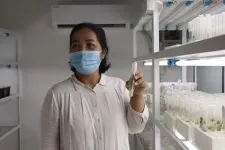(Press-News.org)
U.S. adults experienced considerable psychological distress and adverse mental health effects as a result of the COVID-19 pandemic according to a study at Columbia University Mailman School of Public Health and Columbia University Irving Medical Center. Based on insurance claims, mental health care provider surveys, and electronic health records the research further revealed a decline in in-person outpatient mental health visits during the acute phase of the pandemic. Findings are reported in the Annals of Internal Medicine.
“The trends and patterns we observed in the United States align with reports globally concluding that several mental health problems, including depression, and generalized anxiety disorder, have become more prevalent during than before the pandemic,” said Mark Olfson, MD, MPH, professor of Epidemiology at Columbia Mailman School of Public Health, and Dollard Professor of Psychiatry, Medicine & Law at Columbia University Irving Medical Center.
To characterize the psychological distress experienced, determine the level of outpatient mental health care, and describe patterns of in-person versus telemental health care, the researchers studied the responses of adults from the Medical Expenditure Panel Surveys by the Agency for Healthcare Research and Quality Component, a nationally representative survey of over 85,000 people. Psychological distress was measured with a 6-point scale range and outpatient mental health care use was determined via computer-assisted personal interviews.
The rate of serious psychological distress among adults increased from 3.5 percent to 4.2 percent from 2018 to 2021. While outpatient mental health care increased overall as well -- from 11.2 percent to 12.4 percent, the rate among adults with serious psychological distress decreased from 46.5 percent to 40.4 percent. Young adults (aged 18 to 44 years significantly increased outpatient mental health care but this pattern was not observed for the middle-aged (aged 45 to 64 years) and older adults (aged >65 years). Similarly, more employed adults reported outpatient mental health treatment care compared to the unemployed.
In 2021, 33 percent of mental health outpatients received at least one video visit. The likelihood of receiving in-person, telephone, or video mental health care varied across sociodemographic groups; percentages of video care were higher for younger adults than for middle-aged or older adults, women compared with men, college graduates compared with adults with less education, the seriously distressed, lower-income, unemployed, and rural patients.
“Thanks to a rapid pivot to telemental health care, there was an overall increase during the pandemic of adults receiving outpatient mental health care in the United States. However, the percentage of adults with serious psychological distress who received outpatient mental health treatment significantly declined. Several groups also had difficulty accessing telemental health care including older individuals and those with lower incomes and less education,” observed Olfson. “These patterns underscore critical challenges to extend the reach and access of telemental health services via easy-to-use and affordable service options.”
“Increasing our understanding of the patterns we observed in terms of access to outpatient mental health care including in-person, telephone-administered, and internet-administered outpatient mental health services could inform ongoing public policy discussions and clinical interventions,” noted Olfson. “Identifying low-cost means of connecting lower-income patients to telemental health should be a priority, as well as increasing public investment to make access to high-speed broadband universal.”
“The national profile of adults who receive outpatient mental health care via telemental health – the younger adult, the employed, higher-income, and privately insured adults, raises concerns about disparities in access to virtual mental health care,” said Olfson. “Unless progress is made in reducing these barriers, primary care clinicians will continue to encounter challenges in connecting their older, unemployed, and lower income patients to video-delivered outpatient mental health care.”
Co-authors are Chandler McClellan and Samuel H. Zuvekas, Agency for Healthcare Research and Quality; Melanie Wall, Columbia Mailman School of Public Health; and Carlos Blanco, National Institute on Drug Abuse.
Columbia University Mailman School of Public Health
Founded in 1922, the Columbia University Mailman School of Public Health pursues an agenda of research, education, and service to address the critical and complex public health issues affecting New Yorkers, the nation and the world. The Columbia Mailman School is the fourth largest recipient of NIH grants among schools of public health. Its nearly 300 multi-disciplinary faculty members work in more than 100 countries around the world, addressing such issues as preventing infectious and chronic diseases, environmental health, maternal and child health, health policy, climate change and health, and public health preparedness. It is a leader in public health education with more than 1,300 graduate students from 55 nations pursuing a variety of master’s and doctoral degree programs. The Columbia Mailman School is also home to numerous world-renowned research centers, including ICAP and the Center for Infection and Immunity. For more information, please visit www.mailman.columbia.edu.
END
UPTON, NY—Scientists at the U.S. Department of Energy’s (DOE) Brookhaven National Laboratory have discovered that adding a layer of magnesium improves the properties of tantalum, a superconducting material that shows great promise for building qubits, the basis of quantum computers. As described in a paper just published in the journal Advanced Materials, a thin layer of magnesium keeps tantalum from oxidizing, improves its purity, and raises the temperature at which it operates as a superconductor. All three may increase tantalum’s ability ...
In a recent breakthrough, DNA sequencing technology has uncovered the culprit behind cassava witches’ broom disease: the fungus genus Ceratobasidium.
The cutting-edge nanopore technology used for this discovery was first developed to track the COVID-19 virus in Colombia, but is equally suited to identifying and reducing the spread of plant viruses. The findings, published in Scientific Reports, will help plant pathologists in Laos, Cambodia, Vietnam and Thailand protect farmers’ valued cassava harvest.
“In Southeast ...
CHICAGO, Feb. 5, 2024 – Nonsteroidal anti-inflammatory drugs (NSAIDs) taken alone or along with acetaminophen are recommended as first-line treatments for managing short-term dental pain in adults and adolescents aged 12 or older, according to a new clinical practice guideline developed by the American Dental Association (ADA), the University of Pittsburgh School of Dental Medicine and the Center for Integrative Global Oral Health at the University of Pennsylvania School of Dental Medicine. The guideline has been endorsed by the ADA and is now available in the February issue of The Journal ...
COLUMBUS, Ohio – White Americans are more likely than Black and Hispanic people in the United States to experience “deaths of despair” even though they are less likely to suffer from severe psychological distress, a new study finds.
The results suggest that, for some reason, whites are more vulnerable to the damaging effects of psychological distress than Blacks or Hispanics, said Hui Zheng, lead author of the study and professor of sociology at The Ohio State University. Zheng is currently on leave at the University of Hong Kong.
“The white population has an increasing trend of despair-related mortality after 2000,” Zheng said. ...
EVANSTON, Ill. — When carbon molecules from plants enter the soil, they hit a definitive fork in the road.
Either the carbon gets trapped in the soil for days or even years, where it is effectively sequestered from immediately entering the atmosphere. Or it feeds microbes, which then respire carbon dioxide (CO2) into the ever-warming environment.
In a new study, Northwestern University researchers determined the factors that could tip plant-based organic matter in one direction or the other.
By combining laboratory experiments and molecular modeling, researchers ...
Climate change is already harming agricultural yields and may one day pose a significant threat to the world’s food supply. Engineering more resilient crops, including those able to thrive in the face of drought or high soil salinity levels, is an increasingly urgent need.
A new study from the Keck School of Medicine of USC, funded in part by the National Institutes of Health, reveals details about how plants regulate their responses to stress that may prove crucial to those efforts. Researchers found that plants use their circadian clocks to respond to changes in external water and salt levels throughout the day. That same circuitry—an ...
Methods commonly used to measure poverty can lead to vastly different conclusions about who actually lives in poverty, according to a new Stanford University-led study. Based on household surveys in sub-Saharan Africa, the first-of-its-kind analysis, published Feb. 5 in Proceedings of the National Academy of Sciences, underscores the importance of accurately defining and measuring poverty. Its findings could help inform how governments, nonprofit organizations, and international development agencies allocate resources and evaluate the effectiveness of poverty-alleviation policies around the world.
“They say you can’t manage what ...
The workings of the ultrasonic warning sounds produced by the wings of a species of moth have been revealed by researchers at the University of Bristol.
Scientists recently discovered that moths of the genus Yponomeuta (so-called ermine moths) have evolved a very special acoustic defence mechanism against their echolocating predators—bats.
Ermine moths produce ultrasonic clicking sounds twice per wingbeat cycle using a minute corrugated membrane in their hindwing. Strikingly, these moths lack hearing organs and are therefore not aware of their unique defence mechanism, nor do they have the capability to control it using muscular ...
A new analysis by MIT researchers shows the places in the U.S. where jobs are most linked to fossil fuels. The research could help policymakers better identify and support areas affected over time by a switch to renewable energy.
While many of the places most potentially affected have intensive drilling and mining operations, the study also measures how areas reliant on other industries, such as heavy manufacturing, could experience changes. The research examines the entire U.S. on a county-by-county level.
“Our result ...
THIS PRESS RELEASE IS EMBARGOED UNTIL FEBRUARY 5, 2024 at 3:00 PM U.S. EASTERN TIME
Many Indigenous peoples and local communities around the world are leading very satisfying lives despite having very little money. This is the conclusion of a study by the Institute of Environmental Science and Technology of the Universitat Autònoma de Barcelona (ICTA-UAB), which shows that many societies with very low monetary income have remarkably high levels of life satisfaction, comparable to those in wealthy countries.
Economic growth is often prescribed as a sure way of increasing the well-being of people in low-income countries, and ...




